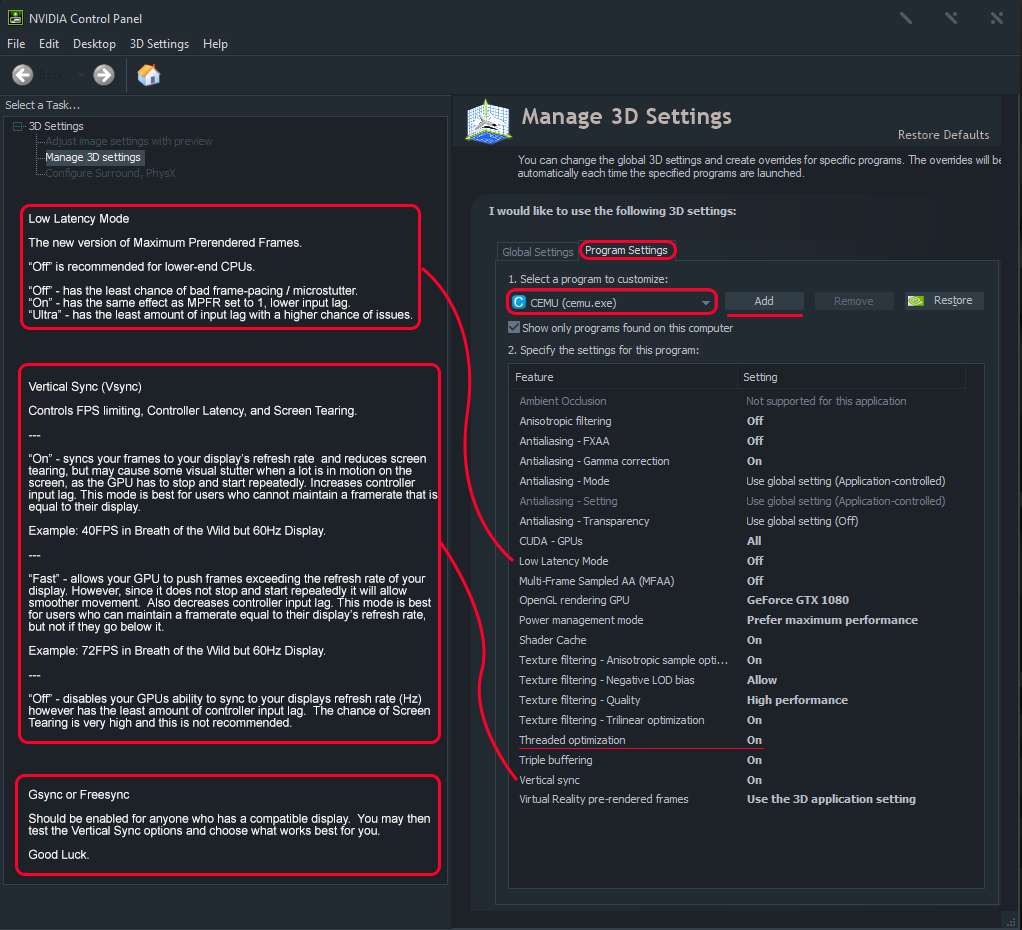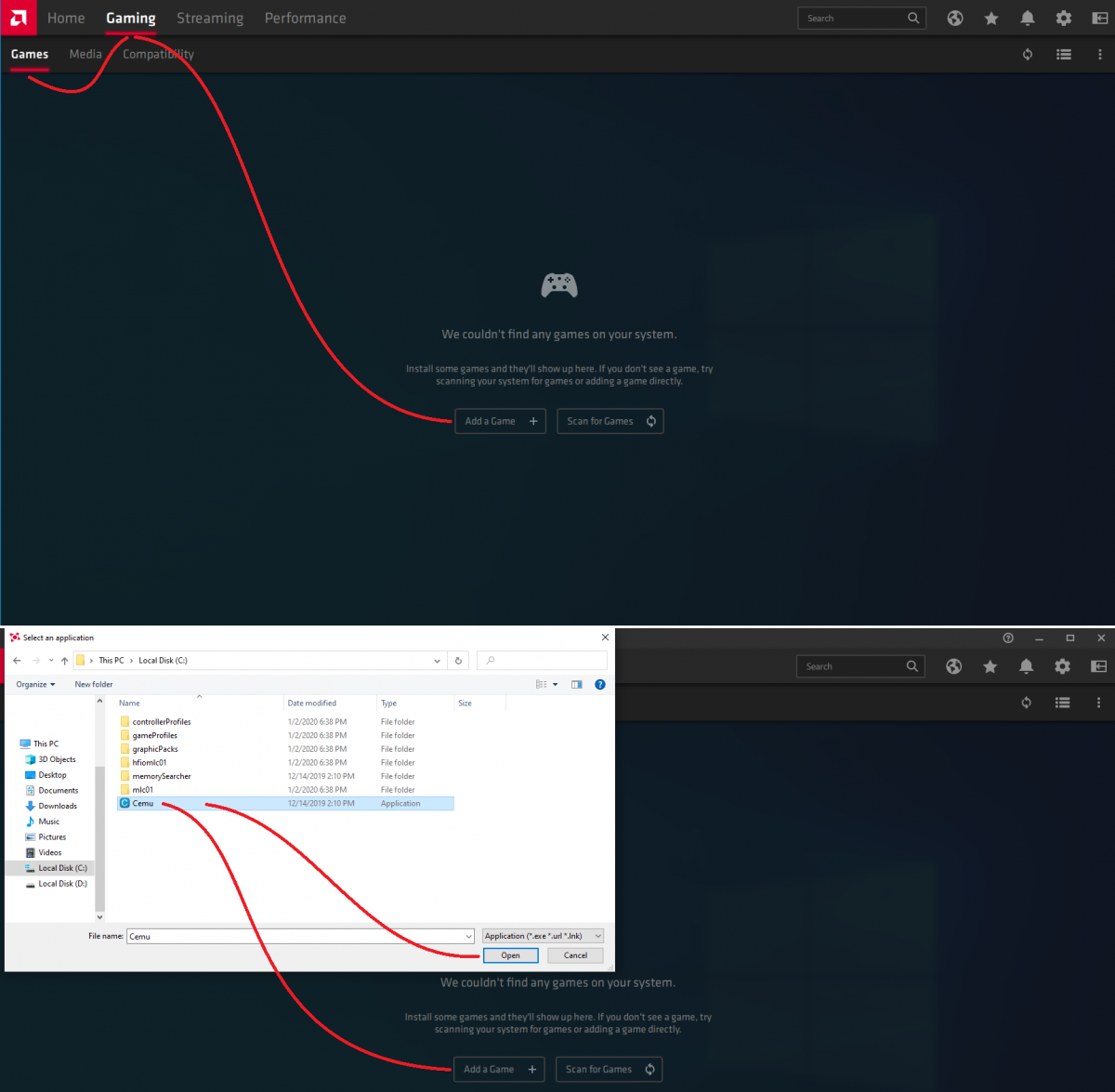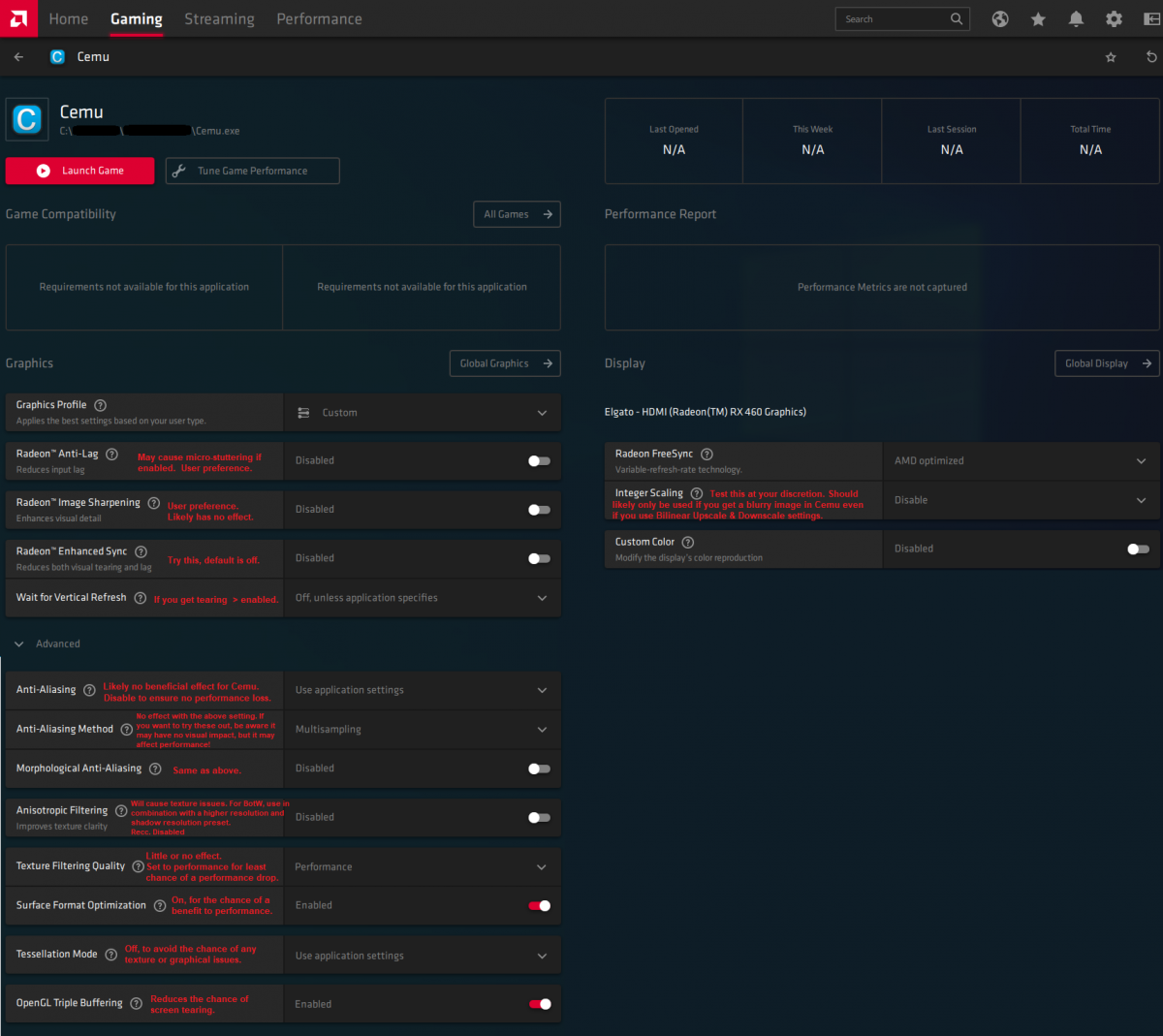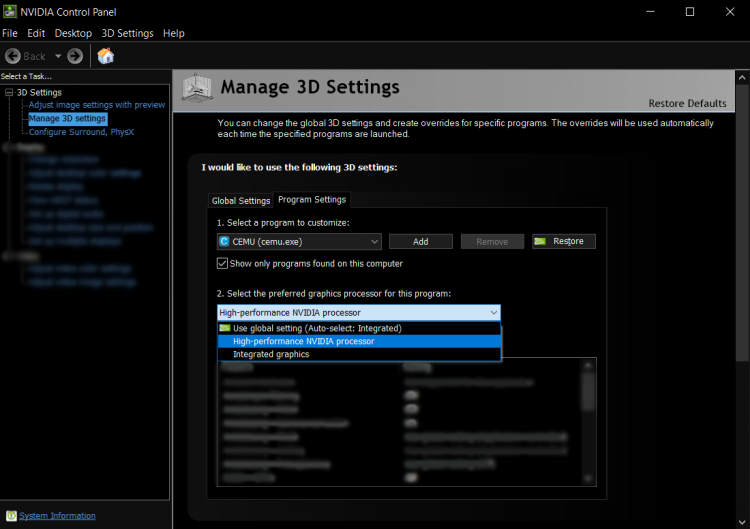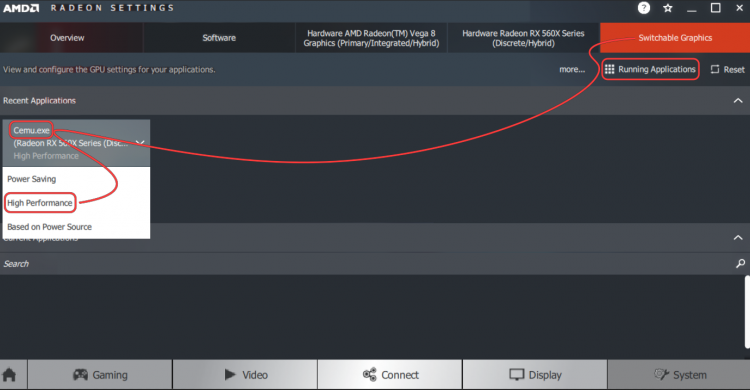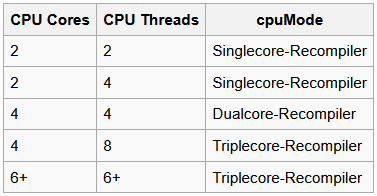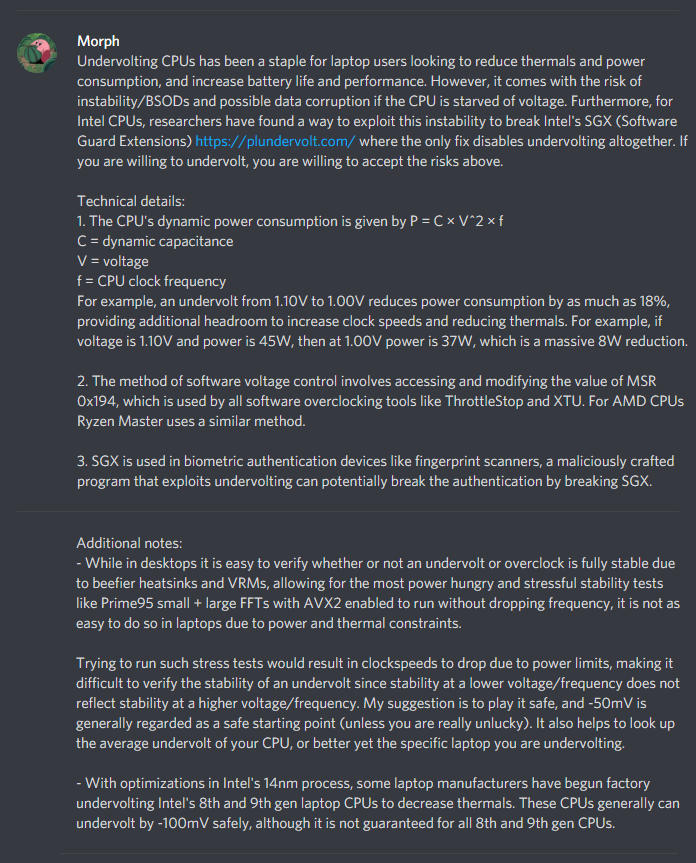Welcome!
Consider reading all of the sections to get a good understanding.
If you're able to do that, any game that is known to perform well should be of little difficulty to run, as long as you have capable hardware.
A large chunk of games will not behave correctly and will be covered by each game's page on the Compatibility List which is linked below.
[ CEMU's Game Compatibility List ]
Last Edit: January 30th, 2020
Public Releases: 1.17.1
Patreon Releases: 1.17.X
Cemu Patreon: https://www.patreon.com/cemu
Cemuhook: v0.5.7.3 is the current compatible version.
Breath of the Wild - Game Update v1.5.0 is recommended for full compatibility.
Game Update from 1.4.0 / 1.4.1 / 1.5.0 is REQUIRED or you will fail to boot (additionally, no FPS++ or graphicPack compatibility.)
Lacking Update causes "Wii U System Update Required" or freezing at "Open your eyes..." and being stuck at 20 to 30FPS, max.
|
Requirements
| What is shaderCache?
|
- Transferrable ShaderCache - This is the first cache made by CEMU. When created, we do not recommend deleting this cache or you will have to replay the game from the very start to obtain the information again. This cache is converted Wii U GPU Shader Code, readable by PCs; it can also be transferred across PCs as it is not affected by different drivers or hardware. It is created when you first encounter an effect, texture, or other environment factor in a game; while it is being cached, the game will freeze momentarily--this is normal and will happen only once per unique shader you encounter. Once you have a Transferrable shaderCache built, CEMU will use it when booting a game in order to create Precompiled shaderCache. You can find Transferrable shaderCaches online but they are likely semi-corrupt; we do not provide download links because this is considered an act of piracy, as they contain copyrighted Nintendo code, extracted directly from games.
- Precompiled ShaderCache - [Note: Nvidia GPU users should have Precompiled Shaders disabled until further notice.] During the game's first boot, introducing the first discovery of shaders for your Transferrable ShaderCache, Precompiled ShaderCache is also generated simultaneously. This cache is converted Transferrable ShaderCache that matches your GPU Driver, Hardware, and CEMU version; each time any of these three things change, the Precompiled Cache will become invalidated & unusable. CEMU will usually detect this automatically and delete it for you, but sometimes it is necessary to delete it by hand as a precaution -- if it's corrupt, sometimes errors will cause games to crash or behave strangely as well. Deleting this cache will require you to wait a longer period of time to load a game until CEMU has fully compiled the Transferrable shaderCache back into Precompiled shaderCache & GLCache.
- GLCache - The GLCache is essentially converted Transferrable/Precompiled ShaderCache used by the OpenGL API of your GPU. When CEMU is compiling your ShaderCache after booting a Wii U Game, you are populating the GLCache for your GPU to avoid stuttering as you attempt to play. With CEMU versions before 1.15.1, this cache gets reset on occasion -- Any games (or applications) that use OpenGL will build a cache and may cause the the size of the GLCache folder to exceed it's threshold of 256MB (Nvidia,) 64MB (AMD), causing the cleaning flag to raise & it is then wiped on the next PC Restart. GLCache will always be wiped after a GPU Driver Update.
- [NVIDIA Users]
- As of Cemu 1.15.1, GLCache for Nvidia will now be stored in the
X:_/_/Cemu/shaderCache/driver/nvidia/ directory; in addition, the GLCache will now be preserved during system reboots and will allow Cemu to continue writing data to it after it reaches 256MB. You should clean the GLCache after each GPU Driver Update you install. Nvidia's drivers do not like Precompiled Cache, therefore games within CEMU will always stutter when using [only] Precompiled ShaderCache--this is because Precompiled ShaderCache on Nvidia does not populate the GLCache as planned; that said, Precompiled Shaders should be disabled.
- Users on pre-1.15.1 versions of CEMU can try to mitigate the effect this has on their gameplay by deleting [AND] disabling their Precompiled ShaderCache and clearing their GLCache in order to repopulate the GLCache entirely.
- [AMD Users]
- On CEMU versions 1.12.1 and after, there was a bug where Precompiled Shaders could not be used, this has been fixed as of 1.14.0
| Precompiled ShaderCache is good for AMD Systems, as GLCache is limited to 64MB.
|
| Precompiled ShaderCache does not work on Nvidia Systems and should be disabled within Cemu's options.
|
| Windows Users can find the GLCache on pre-1.15.1 Cemu builds with ... Run /or/ Search > %localappdata% > Nvidia /or/ AMD > GLCache
|
| Linux Users can find the GLCache on pre-1.15.1 Cemu builds at ... ~/.nv /or/ ~/.amd /GLCache/* (must be viewing hidden files)
|
| Download links are prohibited.
|
| Note: Older Transferable ShaderCaches from pre-1.8.0 will not work with newer CEMU versions.
|
|
| [BotW] 11,000 Cache vs 9,600 Cache?
|
|
Game Update from 1.3.1 to 1.4.0 invalidated caches. Transferrable Cache that was made collectively with both -/1.3.1 and 1.4.0/+, together, will contain duplicates that will not be detected by CEMU as pointless, effectively bloating your RAM. Non-bloated cache for Breath of the Wild should be roughly 9600 shaders. Caches far exceeding this upper limit are known to be from older versions of the game. All other known games should be fine and should not experience this problem.
There is no performance decrease with a bloated cache, however if your RAM is not sufficient to store all data on the RAM and therefore puts it on your HDD/SSD Pagefile, you may notice a sufficient decrease in overall performance for the game in question. Memory Swapping (pageFile,) is often much slower than RAM on its own, depending on the quality and speed of the storage device your pageFile is located on.
In rare cases, more specifically on very slow HDD storage, this may result in crashes of the game.
|
| CPU
|
CPU
Any CPU will work, technically, but non-Ryzen AMD CPUs typically lack Single-Thread processing power; non-Ryzen AMD CPUs may struggle heavily with more demanding Wii U titles.
It is suggested AMD CPU users keep better quality RAM installed (DDR4 3200Mhz recommended,) using more than 1 RAM stick, as emulators are particularly RAM intensive.
- Generally speaking (for Breath of the Wild and almost any CPU), it's recommended to be over your base clock speed where possible for better performance (overclocking.)
- Additionally, Dual-Core or Triple-Core Recompiler options should allow better performance in the few applicable games that support it, especially Breath of the Wild.
You can check out Darkemaster's AMD FX Compatibility Video list for Cemu 1.12.0 [Here] and for 1.15.3~1.15.8 [Here]
Single Thread IPC and Overclocking are the most important factors for how well CEMU will perform on your PC!
I wouldn't recommend going under a score of ( 1,800 ) if you plan to play Breath of the Wild at 1080p 30FPS (Native Wii U Framerate)
Experimental Multi-Core Recompiler Info
See the Recommended Settings section for what is recommended under CPU Options / Affinity.
This experimental setting allows extra cores to be utilized for PPC CPU emulation instead of 1, however not many games actually utilize multiple PPC cores and currently causes stability issues/crashes or offers no benefit for most titles.
| Dual Core Recompiler [requires] a minimum of 4 Cores + Threads available. Not recommended for Dual Core (2 cores+threads) CPUs; system instability.
Triple Core Recompiler [recommends] a minimum of 4 to 6 Cores + Threads available. Not practical to use on pre-8th generation i5 and pre-6th generation i7 Intel CPUs, and most 4-core CPUs.
|
|
| RAM
|
RAM
We recommend at least 8GB RAM for most games, but preferably 16GB+.
If you run out of RAM and have a very slow SATA HDD, you are either likely to stutter relentlessly in-game or you may possibly have Crashes.
Solid State Drives (SSD) are a boon to users with lesser amounts of RAM, as your PC will push data to the PageFile on your SSD if you set it to do so. They are much faster than SATA drives and therefore less likely to become unstable and crash with lesser amounts of RAM.
PageFile: A pagefile (virtual memory) is essential to have in order to avoid crashing when running out of available RAM. Instead of crashing immediately when exceeding RAM limit, you may experience lower performance when a pagefile is used and may also experience additional in-game stutter when swapping. One way to see if one is using a pagefile while using Cemu is to see their "total commit size" in task manager and pay attention to if the number shown being used exceeds the amount of physical RAM installed within your PC, as pagefile usage is typically not shown under RAM usage statistics.
Your GPU vendor can also play a role in what your RAM usage will be in Cemu and will determine how essential a pagefile is, or how often it will be used, if at all.
|
It is recommended to have a pagefile on an SSD or the fastest drive available, and to leave pagefile size as System managed size. Altering your pagefile size may cause your PC to become unstable, resulting in crashes of your entire system.
Alternatively, some users suggest to have a custom size of .5 times your physical RAM as Initial size(MB) and 1.5 times your physical RAM as Maximum size(MB). Research is highly recommended before changing your pagefile settings.
|
| GPU
|
GPU
NVIDIA GPUs are recommended; they can take some strain off of your CPU and have better performance through threaded optimization/OGL multi-threading when under heavy CPU workloads.
AMD GPUs perform great for all but the heaviest of games, their performance is HIGHLY dependent on your CPU processing capabilities. This may all change with Vulkan implementation in the future.
Intel Integrated Graphics (iGPUs) are not officially supported but have decent compatibility.
| A comprehensive list of all known current GPU-vendor specific bugs and available workarounds in Cemu can be found here - GPU Compatibility List
|
GPU power and available VRAM is not very important unless you want to increase your game's internal resolution or reaching higher FPS limitiations. If you lose noticeable performance when playing at a higher resolution it means you are GPU/VRAM limited and your graphics card/VRAM amount is not sufficient to maintain said resolution without a performance loss. It is possible to be GPU/VRAM limited at native resolution with weaker/1GB-2GB GPUs and iGPUs, to determine if you are throttling when under these conditions, lower your game's resolution and see if performance improves.
[BotW] For 4k @ 30FPS or 1440p (2k) @ 60FPS
It is recommended to use a modern GPU with at minimum 4GB VRAM.
Reaching 60FPS is almost entirely determined by your CPU.
95% of users will not obtain stable 60FPS even with optimal settings.
A large majority of users will not obtain 60FPS no matter what.
|
[Any Game] Standard Gameplay at 720p / 1080p Native Wii U Resolution
We recommend anything in range of a NVIDIA GTX 600 or AMD HD 7000 series or above.
|
|
Installing & Updating CEMU
| Setup
|
Setup
First Installation:
Download CEMU from http://cemu.info/ and extract the .ZIP to a folder in one of these locations:
Recommended: SSD Storage
a. ) Desktop
b. ) Your C:\ Drive Root
c. ) An alternative internal storage drive.
d. ) An external storage device.
Note: Not recommended unless USB 3.0 or 3.1; depending on the device, it may have slow data read/write speeds.
However, even with slower read/write speeds (if you have a full ShaderCache) this should not hinder your performance!
Do NOT put it in your Program Files or other system directories, CEMU will lack permission to write saves, shadercache, and other info!
- Open the folder, right-click on
Cemu.exe -> Properties -> Compatibility
- If available, enable the option resembling:
Use this setting to fix scaling problems for this program instead of the one in Settings
- If available, enable the option resembling:
Change high DPI settings
Override high DPI scaling behavior. Scaling performed by: Application
- If available, enable
Disable fullscreen optimizations
- Lastly, enable
Run this program as an administrator (This is to ensure you have full permissions.)
|
| Updating
|
Updating
As of Cemu 1.15.10, you can now use the [ Help > Check for Updates ] option to update Cemu. If you're on this version or newer, you can ignore the rest.
Optionally, you may enable checking for updates automatically in Options > General Settings.
You simply download the new update and extract the .zip'd files over your older Cemu version. That's all you have to do presently, to update Cemu.
If you're upgrading from a version before 1.15.1 you will need to delete your graphicPacks.
After updating CEMU, use the download button in the graphicPack window to download them fresh.
Use this button to update the packs from now on.
You should always make sure your Cemuhook is up-to-date. https://cemuhook.sshnuke.net/
|
| Older CEMU Versions
|
Archive of Cemu Releases
You can copy the download link from Cemu's download page, paste into your URL bar, and edit the version number to point to the version you wish to download.
- Choosing of a/b/c/d+ versions not available for download while using this method.
You may also grab downloads from this forum topic by QwerkyPenguin: [ Click Here ]
|
Recommended Settings
| Cemuhook [Required]
|
|
REQUIRED FOR FPS++, TEXT, and VIDEOS
Download Cemuhook by Rajkosto from: https://sshnuke.net/cemuhook/
Extract dbghelp.dll & keystone.dll from the Cemuhook ZIP into your Cemu folder, next to Cemu.exe
When opening Cemu, make sure to download your Shared Fonts.
| Open Cemu > Download the Shared Fonts with the link that appears in the main window.
|

These are REQUIRED for various titles to function correctly, such as Mario Kart 8, Super Smash Bros. Wii U, Mario Tennis: Ultra Smash, and Super Mario Maker; along with other titles!
- Cemuhook also allows the following:
- Extended CPU Menu options.
- Allows you to set up a Gyro-enabled Device / Controller / Phone to use with Motion Control games.
- Allows in-game cutscenes to play on various titles instead of crashing or a glitchy green-screen. (H264)
- Lets you play games in fast-forward or slow-motion mode under Debug.
|
| Cemu's Properties Settings
|
Cemu's Properties Settings
- Open the folder, right-click on
Cemu.exe -> Properties -> Compatibility
- If available, enable the option resembling:
Use this setting to fix scaling problems for this program instead of the one in Settings (This ensures your next options are always used for Cemu.)
- If available, enable the option resembling:
Change high DPI settings
Override high DPI scaling behavior.
Scaling performed by: Application (This is to prevent a blurry or blocky image that some users experience.)
- If available, enable
Disable fullscreen optimizations (Currently unknown but may prevent some issues with older OS versions.)
- Lastly, enable
Run this program as an administrator (This is to ensure you have full permissions to write save data, shaderCache, etc.)
|
| GPU Settings
|
| Recommended iGPU Settings
|
Recommended iGPU Settings
Integrated Graphics are highly advised against for emulation as they do not often meet MANY requirements.
Make sure it's running on Maximum Performance Mode.
| iGPU (Intel Integrated Graphics) Users who experience problems can try this: (Keep in mind this will likely cause other games to fail to boot that would previously.)
Users should create a CEMU shortcut, edit its properties, adding -nolegacy to their Target: [ See Here ]
Note: As of CEMU 1.15.1, -nolegacy is default. You may try using -legacy instead.
If the issue persists, it's one of the following: update your iGPU driver, the game will not work for that specific iGPU, or your iGPU is simply too old.
|
|
| Recommended Nvidia Control Panel Settings
|
Recommended Nvidia Control Panel Settings
|
| Recommended AMD Radeon Settings
|
Recommended Radeon Settings
|
| Laptops with Dual Graphics
|
Laptops with Dual Graphic Cards
Ensure your laptop is using your desired GPU for Cemu, otherwise you will likely be using Intel Integrated Graphics (iGPU)
Nvidia Users: Open Nvidia Control Panel > Manage 3D Settings > Program Settings > Set the preferred GPU for CEMU.exe
AMD Users: Open the Radeon Settings panel > System Tab > Switchable Graphics Tab > Ensure that Cemu is set to High Performance.
|
|
| CEMU Settings
|
| Options → General Settings
|
| General Tab
|
General Tab
- Interface:
- Language:
- Recommended: User Preference
Translates CEMU's UI to the users' preferred language.
- Remember Main Window Position:
When opening and closing the emulator, it will revert to the same size & position it had during the last session.
- Remember Pad Window Position:
When opening and closing the the separate GamePad window, it will revert to the same size & position it had during the last session.
- Discord Presence:
Enables Discord Rich Presence when users view your status; shows what Wii U game you're playing, etc.
- Fullscreen Menu Bar:
Enables the menu bar for options while in Fullscreen.
- Automatically check for updates:
If enabled, will check online for updates on each startup of the application, will then apply the updates.If disabled, you may check for updates using the Menu Bar > Help > "Check for updates" option.
- Save screenshot:
Instead of only going to the clipboard, screenshots will then be saved to *\Cemu Folder\Screenshots
- MLC Path:
Optionally change where installed Game Updates, DLC, Save Files, and other Wii U NAND information is stored.
Default location is *\Cemu Folder\mlc01\
- Game Paths:
Where your games are stored. You can have multiple paths.
|
| Graphics Tab
|
Graphics Tab
- General:
- Graphics API:
-
- Nvidia:
- OpenGL -
Consumes 400% more RAM than Vulkan, but has better performance & less graphical issues in many games for the time being.
- Vulkan -
Not as optimized for speed, but recompiling shaders & building them in-game take much less time. There are still graphic bugs & various problems in different games.
- AMD:
- OpenGL -
Performance is very poor compared to Vulkan and there are many incompatibilities with different AMD architectures, but can be more stable than Vulkan.
- Vulkan -
Since it allows multithreading, performance is roughly 50% better than OpenGL, but there are still many quirks that need addressed.
- Intel:
- OpenGL -
Placeholder Text Test if you wish.
- Vulkan -
Placeholder Text Test if you wish.
- Precompiled Shaders:
-
With Auto, Cemu will detect your GPU and set the setting accordingly.Precompiled shaderCache does not work for Nvidia GPUs at this time; it does work for AMD and Intel GPUs.
- VSync:
-
Under most circumstances, should always be enabled.
- Full sync at GX2DrawDone:
- Recommended: Enabled (It's okay to disable it with OpenGL, but should be left on for Vulkan. Will break BotW's Camera Rune when Disabled.)
Decreases performance when enabled due to syncing the CPU and GPU, much like the Wii U. Prevents some bugs in Breath of the Wild.
- Upscale Filter:
-
For pixel-art games, using Nearest Neighbor will keep the game sharp (play in fullscreen mode). Test to see which filter looks better for you though.
- Downscale Filter:
-
For pixel-art games, using Nearest Neighbor will keep the game sharp (play in fullscreen mode). Test to see which filter looks better for you though.
- Fullscreen Scaling:
- Recommended: Keep Aspect Ratio
"Stretch" may be good for uncommon display resolutions.
- Overlay:
A set of options that provide statistical data as an on-screen overlay during gameplay.
- Notifications:
A set of options that provide additional information as a temporary overlay popup.
- Shader compiler:
This will let users know when they are currently compiling new shaders while playing.
- Friend list:
If you have Online Mode and Nintendo Server access with your Wii U files, a notification will appear when any players in your Wii U Friendlist come online on Nintendo's Servers.
|
| Audio Tab
|
Audio Tab
- General:
- API:
-
You can test the alternative option if you desire.
- Latency:
-
If you notice crackling audio in games, you should try increasing the latency until it stops.
- TV:
- Device:
Select which audio device you wish to use for (Main) TV Output.
- Channels:
Stereo is the only option available for now.
- Volume:
- Gamepad:
- Device:
Select which audio device you wish to use for Gamepad Audio.
- Channels:
Stereo is the only option available for now.
- Volume:
|
|
| Menu Settings (Options / CPU / Debug)
|
| Options Menu
|
- GX2SetGPUFence skip (HACK): This option is no longer available in recent versions.
-
Breath of the Wild only, this option is no longer required as FPS++ sets it automatically with an improved process.
- GPU Buffer Cache Accuracy: Keeping all of these settings at Default is recommended.
Note: Will be greyed-out if a gameProfile has set this option automatically.
-
Very few games require High.- Recent Versions:
You may set this by right-clicking the game in Cemu's List and opening the GameProfile.
- Old Versions:
You may set this by editing the GameProfile.ini text file by placing -
GPUBufferCacheAccuracy = # ; 2=Low, 1=Mid, 0=High ] under [Graphics]
- Experimental: There is no longer an experimental option set in recent versions.
- Use RDTSC: This option is now enabled by default in recent versions and cannot be turned off.
-
Enables Cemu's more accurate CPU & Audio timing mode.
|
| CPU Menu
|
|
- The CPU > Mode section in the CPU Menu is no longer used. This has been replaced with options in each game's GameProfile.
- To access a game's GameProfile, right-click the game in your Cemu Game List. You may then follow the following options.
- The CPU > Affinity section is still under the CPU Menu, not within GameProfiles.
- The CPU > Mode option should be left at Single Core given the chance you may try to run a game that is not documented well.
- Mode: Dependent on your CPU type and if the game is compatible. (See the Compatibilty Wiki link at the top of this Guide)
Note: Will be greyed-out if a gameProfile has set this option automatically.
The Mode Menu has been removed as of Cemu 1.17.2 - these settings are now set in each game's GameProfile.
- Single-Core Interpreter:
Not recommended except for debug and testing purposes. Slow.
- Single-Core Recompiler:
- Recommended for most games, the other choices will likely fail to boot or freeze the game. Testing is welcome.
Additionally, recommended for Dual Core CPU owners.
- Dual-Core Recompiler:
- On few supported games: 4-Core+ CPUs can see a performance gain.
Breath of the Wild is supported.
- Triple-Core Recompiler:
- On few supported games:
Some 4-Core and most 6-Core+ CPUs can see a performance gain.
4-Core CPUs can see better FPS Stability but lesser FPS, but some will obtain better FPS; possibly increased CPU temperatures.Breath of the Wild is supported.
- Affinity (OpenGL):
Note: Affinity settings can only be changed if you have Cemuhook added to CEMU.
Test each option in-game to see what benefits your performance the most then stick with it for that game.
- 2-Core CPUs should always use "All Logical Cores"
- 4-Core 4-Thread CPUs that use Dual-core Recompiler should try each option and see which gives them the best performance.
- 4-8+Core 8+Thread CPUs that use Triple-core Recompiler should likely use "All Logical Cores"
- Affinity (Vulkan):
Note: Affinity settings can only be changed if you have Cemuhook added to CEMU.
Test each option in-game to see what benefits your performance the most then stick with it for that game.
- Dual-core CPU Owners should always use "All Logical Cores"
- 4-Core 4-Thread CPUs that use Dual-core Recompiler should try each Affinity option and see which gives them the best performance.
- 4-8+Core 8+Thread CPUs that use Triple-core Recompiler should also try each Affinity option and see which gives them the best performance.
|
| Debug Menu
|
|
(These options will only be enabled with Cemuhook added to Cemu)
- Logging:
-
(Logging should only be enabled if a Cemu Dev or other user asks you to provide more logging information.)
- Custom Timer:
- Recommended: Cemu Default
- QPC and RDTSC options let you use the timer speed multiplier options.
- This is mainly only good for collecting shaderCache quickly. Buggy & crashy.
- MM Timer Accuracy:
- Use Cemuhook H264:
- Recommended: Enabled, for now.
This is used to correctly render and play pre-recorded cutscenes and other types of content within games. Otherwise, Greenscreen.(Cemu will eventually have flawless H264 support by itself, this will then be unneeded.)
|
|
|
Getting your Game Data & Online Files from your Wii U
| Online Play
|
Online Play
To connect online you'll require your Wii U with Homebrew support, and a way to dump files from your Wii U NAND onto your SD Card or an FTP client.
Follow this guide from Flocker: Click Here
|
| Online Local Co-op
|
Parsec
Check out this thread and video to get started; decent internet connection recommended. [Click Here]
|
PC Optimizations
| Windows 10 PC Optimizations
|
Windows 10 PC Optimizations
| Windows 10 Exploit Protection:
(Introduced with Windows 10, version 1709 & newer)
|
| Open your Start Menu, search "Exploit Protection"
Open it, do the following:
|
Open "Program Settings"
+ Add a Program to Customize
Add by Program Name
Add Cemu.exe
Enable the Checkmark for all Options
Leave all Switches in the Off position
Click [Apply]
If you rename Cemu.exe this change will no longer apply until it is renamed again.
I haven't gone out of the way to test the performance draw on any of these
settings but I suggest you just let Cemu do what it needs to do. One or more
of these Exploit Protections have been known to diminish the performance of
different game titles; not specifically Cemu.
Do not run a Cemu.exe from a source that is not https://cemu.info or Cemu's Patreon,
this will put you at immediate risk for threats when disabling Exploit Protection.
|
| Windows 10 Background Services:
|
| Open Msconfig ( Win Key + R > Type " msconfig.exe " > Press Enter > Navigate to " Services " )
Disable the Following:
|
Xbox Accessory Management Service
Xbox Live Auth Manager
Xbox Live Game Save
Xbox Live Networking Service
Apply your changes. Close msconfig.
Open Control Panel
Search Game
Open Game Bar Settings
Disable the Game Bar
Open Game Mode Settings
Disable the Game Mode
You may want to test Game Mode on and off.
Keep in mind you may want to re-enable these for PC games in the future.
Restart your PC
|
These services are unnecessary for Cemu and you can see a rough 1~5 FPS increase.
For games you want to use them with, make sure to enable the services again and reboot.
If you use any Xbox-integrated programs like Xbox Messages, Xbox Live, etc..
You will be required to enable these services and restart the PC before they will work again.
Additionally, make sure all programs that are running are closed before running CEMU.
Simply having Discord, Firefox, or Google Chrome open can decrease your performance.
I recommend the following:
- Process Explorer: Click Here (A more powerful Task Manager)
| Disable OSD Monitoring Programs (On-Screen Displays):
|
Using OSDs may cause severe FPS drops or graphical issues while using CEMU. Make sure they're disabled for the duration of play.
(This includes Nvidia's overlays, Win10 Xbox Game Bar, Steam Overlay, and other types of rendering software.)
|
| Playing BotW on OpenGL Nvidia? Only have 8GB of RAM? Try this:
|
| Within CEMU, right-click your game and go to its GameProfile
Under [Graphics], edit the Line:
accurateShaderMul = true changing "true" to "min"
Note: This may disable some textures, however it can save quite a bit of RAM.
( i.e. Going from 12GB free required to 8GB free required. )
This will help you avoid stuttering when you run out of available RAM,
But if you do run out of available RAM, stuttering will be unavoidable.
Precompiled Shaders should be disabled on Nvidia Systems. Ensure that
you have done this. Afterwards, delete the Precompiled Cache to restore
some harddrive space as they are unneeded for Nvidia systems.
|
|
| AMD Ryzen CPU Simultaneous Multithreading - (Look into the tool Ryzen Master)
|
|
Ryzen Master is a tool that may be used, paired with a Ryzen CPU. Whether or not this will help your performance is mainly determined by which Ryzen CPU you have and your amount of RAM / quality of RAM.
When using Ryzen Master, all you need to do is create a new profile. You can call this profile "Cemu" or whatever you wish, as this setting may end up helping with some other games if you go through and test with any titles you have had issues with in the past.
With this profile active, disable SMT. (Simultaneous Multithreading) - This setting being used by default may actually reduce performance across the cores when using games or programs that exclusively want to work on a few set cores. Disabling SMT usually helps in Cemu's case, but you will want to keep an eye on your actual performance numbers.
If SMT being disabled has not done much for you, your next option is to enable the Game Mode. This is typically it's own profile, I'm not aware if you can edit it. In either case Game Mode will disable some of your CPU cores to help restrain processes to certain cores, almost like disabling SMT but not the same. If this works better for you than disabling SMT, I would suggest using it each time you plan to play.
If neither disabling SMT or Game Mode benefit your performance, I suggest just leaving everything alone. At the very least I wanted to provide this suggestion as I have gotten some great results from people in the past.
|
| AMD GPU owners trying OpenGL, use Linux - (+20~50% Performance)
|
AMD GPU owners + Linux (Better Performance)
AMD's lack of performance on OpenGL is due to their deprecated Windows OpenGL support since moving their attention to the Vulkan API. Had AMD added additional compatibility extensions it would not have the problems it does, and to be fair, it's mainly Breath of the Wild that is affected. Will AMD ever improve their OpenGL driver support?--We don't know. Probably not.
In the meantime, Linux users can use MESA drivers for AMD which aren't applicable to Windows systems, seeing anywhere between a 20~50% performance increase in contrast.
Lutris, for automatically installing Cemu on Linux -
Alternative, courtesy of Discord user Johngalt#5368 -
- It's pretty much streamline from there.
- Further support for Linux related questions can all be discussed within our Official Discord in the #Linux channel.
|
| Undervolt your CPU - (Decrease temperatures, stabilize performance)
|
Undervolt your CPU
I haven't delved very far into this personally, but Morph has provided information in the image below.
However, if you're interested in learning more you can (Click Here)
The main reason you'd like to do this is for Desktops & Laptops where heat becomes a problem, relating to the BDPROCHOT section below and Ryzen Master section, above.
|
| Disable BD PROCHOT - (Stop your PC throttling from heat earlier than necessary)
|
Disable BD PROCHOT
It's highly recommended you research this topic before deciding to attempt it. If you fry your hardware, I take no responsibility.
An informative Reddit post can be found here: Link
BD PROCHOT - Stands for Bi-directional Processor Hot. PROCHOT is an emergency throttling system that is used when a CPU hits its maximum temperature (100 or 105C). BD PROCHOT is a system some laptops use where the CPU will be throttled when another component, such as a GPU, reaches a set temperature—even if the CPU is not hot to the point of throttling.
Some laptops trigger thermal throttling as low as 60~70c, well below the maximum safe temperature. You can look into ThrottleStop and their documentation, then see if this is what's causing your CPU Core Performance to always drop below its suggested speeds.
ThrottleStop Guide
|
| Disable CPU Parking - (Stop your CPU from starting & stopping cores/threads)
|
Disable CPU Parking
It's highly recommended you research this topic before deciding to attempt it. If you fry your hardware, I take no responsibility.
By default, core parking basically makes your processors go into a sleep state known as (C6) and is supported by most new processors. This allows your computer to save power. There is a trade off for disabling parking. If you use a laptop or tablet, you may notice a slight difference in battery life once you disable core parking on your CPUs. If you disable core parking on your CPUs, your computer may have faster benchmarks. (Reported higher frame rates by gamers and power users).
How can this speed up my computer? Imagine that you have four engines and every time you stop and start you also turn some of the engines on and off. With all of your CPUs ‘on’, your engines are always ready to go. Does this work on all processors? No. Has there been reported improvements? Yes.
ParkControl Download
ParkControl Activator (Crack)
|
If want to chat about games, tech, or need some help - join our Discord Server
For quick and reliable support, feel welcome to come by the Discord. https://discord.gg/5psYsup
It's more than just for troubleshooting. Our main community discussion hub and development are all focused there.
MAKE SURE TO READ THE #RULES
